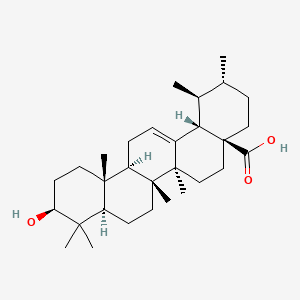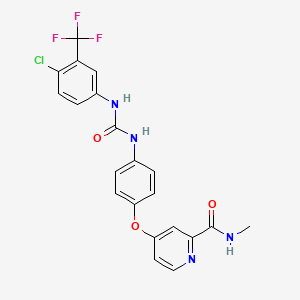


| Pair Name | Ursolic acid, Sorafenib | ||
| Phytochemical Name | Ursolic acid (PubChem CID: 64945 ) | ||
| Anticancer drug Name | Sorafenib (PubChem CID: 216239 ) | ||
| Structure of Phytochemical |

|
Download
2D
MOL
3D
MOL
|
|
| Structure of Anticancer Drug |

|
Download
2D
MOL
3D
MOL
|
|
| Pair Name | Ursolic acid, Sorafenib | |||
| Disease Info | [ICD-11: 2C12] | Hepatocellular carcinoma | Investigative | |
| Biological Phenomena | Induction-->Autophagy | |||
| Gene Regulation | Down-regulation | Expression | MCL1 | hsa4170 |
| In Vitro Model | Hep-G2 | Hepatoblastoma | Homo sapiens (Human) | CVCL_0027 |
| SMMC-7721 | Human papillomavirus-related cervical adenocarcinoma | Homo sapiens (Human) | CVCL_0534 | |
| Huh-7 | Adult hepatocellular carcinoma | Homo sapiens (Human) | CVCL_0336 | |
| H22 | Hepatocellular carcinoma | Mus musculus (Mouse) | CVCL_H613 | |
| In Vivo Model | To assess the inhibitory effect of different drugs on mouse liver cancer xenografts, six experimental groups of mice were randomly set up: (1) Control (saline), (2) UA (4 mg/kg), (3) Sora (4 mg/kg), (4) UA + Sora (UA 4 mg/kg, Sora 4 mg/kg), (5) US NPs (UA 4 mg/kg, Sora 4 mg/kg), (6) US NPs + rapamycin (UA 4 mg/kg, Sora 4 mg/kg), 6 mice in each group. | |||
| Result | The carrier-free US NPs provide new strategies for HCC treatment and new ideas for the development of novel nano-drug delivery systems containing UA and Sora. | |||
| Pair Name | Ursolic acid, Sorafenib | |||
| Disease Info | [ICD-11: 2A00-2F9Z] | Solid tumour or cancer | Investigative | |
| Biological Phenomena | Induction-->Ferroptosis | |||
| Gene Regulation | Up-regulation | Expression | ROS1 | hsa6098 |
| Down-regulation | Expression | MCL1 | hsa4170 | |
| Down-regulation | Expression | SLC7A11 | hsa23657 | |
| Up-regulation | Expression | CASP3 | hsa836 | |
| Up-regulation | Expression | CASP9 | hsa842 | |
| Up-regulation | Expression | CASP8 | hsa841 | |
| Up-regulation | Expression | PARP1 | hsa142 | |
| Up-regulation | Expression | BIM | hsa10018 | |
| In Vitro Model | HCT 116 | Colon carcinoma | Homo sapiens (Human) | CVCL_0291 |
| AGS | Gastric adenocarcinoma | Homo sapiens (Human) | CVCL_0139 | |
| In Vivo Model | HCT 116 cells (3×10⁶), HCT116 Vector cells (3×10⁶), HCT116 Mcl-1 overexpression cells (3×10⁶) and HCT116 SLC7A11 overexpression cells (3×10⁶) suspended in 0.2 ml of PBS were subcutaneously inoculated into the right flank of each mouse. | |||
| Result | These results suggest that the synergistic antitumor effects of sorafenib combined with ursolic acid may involve the induction of Mcl-1-related apoptosis and SLC7A11-dependent ferroptosis. Our findings may offer a novel effective therapeutic strategy for tumor treatment. | |||
| No. | Title | Href |
|---|---|---|
| 1 | Synergistic anti-tumor effect of dual drug co-assembled nanoparticles based on ursolic acid and sorafenib. Colloids Surf B Biointerfaces. 2024 Feb;234:113724. doi: 10.1016/j.colsurfb.2023.113724. | Click |
| 2 | Ursolic acid enhances the antitumor effects of sorafenib associated with Mcl-1-related apoptosis and SLC7A11-dependent ferroptosis in human cancer. Pharmacol Res. 2022 Aug;182:106306. doi: 10.1016/j.phrs.2022.106306. | Click |
